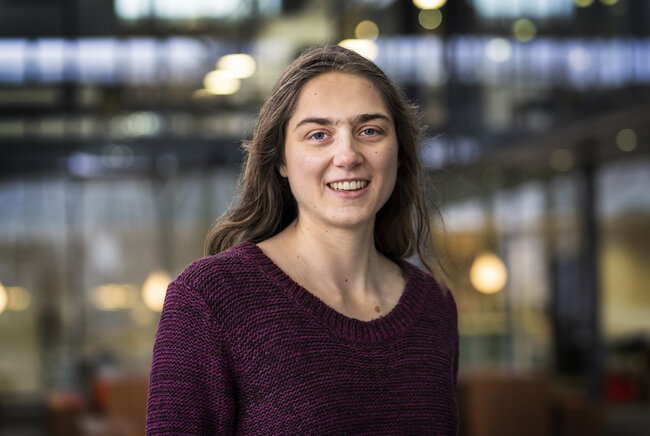Imaging and structural characterization of dairy gels and food emulsions
Mariska Brüls defended her PhD thesis at the Department of Chemical Engineering and Chemistry on March 26th.

To make food healthier and more sustainable, it is important to understand how the properties of food products are formed. Food products are complex; they are composed of numerous building blocks called molecules. The main building blocks of food products are often large molecules such as proteins, carbohydrates, and fats. Not only the composition but also the arrangement of these molecules determines the characteristic structure of food products.
For example, milk and yogurt do not differ much in terms of nutritional value; they contain similar amounts of water, proteins, carbohydrates, and fats. Yet they have very different properties. Yogurt is more acidic than milk, and while milk is an easily pourable liquid, yogurt is much thicker and creamier. How can this be? And why is one yogurt thicker and creamier than another?
Yogurt is made by adding bacteria to milk that convert milk sugars into lactic acid. This process is called fermentation and is the reason yogurt is more acidic than milk. However, acidification also causes the protein particles in milk to clump together into a network. In set yogurt, the structure of this network remains intact, giving it a firm texture that is not pourable. Stirred yogurt is first smoothed out before packaging. It is still thick and creamy but pourable.
Interestingly, the structure of the protein network can be influenced by adjusting the fermentation conditions, such as temperature. Special bacteria can also be used that secrete long carbohydrate chains, polysaccharides, during the fermentation process. The presence of these polysaccharides directs the formation of the protein network. The beauty of this is that the texture of yogurt can be improved naturally, without the need for additives.
In my research, I studied how different types of polysaccharides affect the protein network of yogurt. I used various analysis methods to characterize the yogurt protein network structure in microscopy images. This helps us to understand which properties of polysaccharides lead to the desired yogurt structure, so that eventually we can make yogurt even more delicious naturally!
Another example highlighting the importance of structure in food is mayonnaise. Mayonnaise consists of about 80% oil. But while pure oil is a liquid at room temperature, mayonnaise is firm and creamy and can be scooped with a spoon. This is because in mayonnaise, the oil is packaged into small droplets, surrounded by a thin layer of vinegar or lemon juice. Such a structure is called an oil-in-water emulsion. The droplets significantly hinder each other's movement, making mayonnaise much less fluid than pure oil.
You can try this yourself in the kitchen: by mixing oil with a dash of vinegar in a food processor, your mixture quickly becomes creamy. But beware! Your emulsion will not remain stable for long. The oil droplets soon merge, and before you know it, you are left with an oil layer on top of a vinegar layer.
You can prevent this merging by adding egg yolk. Egg yolk is rich in proteins that like to be at the interface between oil and water. This creates a layer of proteins around the droplets that prevents merging. Proteins from legumes such as soybeans and peas also do this. So, you can also make vegan mayonnaise this way!
I have investigated how different plant proteins interact with the oil in vegan mayonnaise. Depending on their properties and position, these proteins can either accelerate or decelerate oil oxidation, a process that causes oil to become rancid. Using microscopy and image analysis, I have mapped oil and protein oxidation in vegan mayonnaise. With this information, food scientists can develop vegan mayonnaise that stays fresh for longer.
Cursor wrote an article about Mariska's PhD-journey.
Title of PhD thesis: Imaging and structural characterization of dairy gels and food emulsions. Supervisors: Ilja Voets (TU/e) and Johannes Hohlbein (WUR).